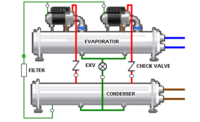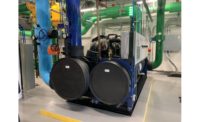Cooling large buildings typically requires the use of air or water-cooled chillers that produce chilled water, which then cools the air. About 39% of buildings larger than 100,000 square feet use chilled-water systems employing various compressor designs. Selecting the right chiller and compressor requires a specifying engineer to determine the building’s cooling load and the proper chiller capacity.1 Calculations are also done to determine the return on investment between different systems by comparing the energy cost per ton of refrigeration along with the operational costs.
When buying a new chiller, specifying engineers and facility owners naturally focus on efficiency ratings to estimate the chiller’s annual energy costs.
In addition to the chiller’s performance ratings, however, there is another variable worth considering: How will the chiller and the chiller’s compressors maintain their rated performance in real-world operating conditions years after the purchase has been made?
A significant factor that affects chiller performance over time is the oil used by the chiller’s compressor. Oil is used to form a seal that prevents refrigerant from returning to the suction port as well as lubricate the compressor bearings, gears, and shaft seals. While necessary for operation, the oil over time becomes entrained in the refrigerant and circulates throughout the system. Eventually, the oil coats the heat exchanger tubes, which creates a thermal barrier that degrades efficiency—a problem known as “oil fouling.”
A number of independent third-party studies detail the consequences of oil fouling, which include:
- A drop in heat transfer ratio from 1.0 to 0.65 at oil concentrations as low as 10%.2
- A loss of 10% efficiency after five years and 20% efficiency loss after 10 years in oil-lubricated chillers at Tsinghua University, China.3
- As much as 30% performance degradation in other cases.4
Performance degradation over time is not only due to oil fouling. Another study shows that traditional oiled compressors, specifically screw compressors, suffer significant performance degradation due to excessive bearing wear, capacity slide damage, and other factors over years of operation.5 This study concluded that screw compressor wear significantly impacts performance by the fifth year of operation, and subsequent performance degradation was found to be as high as 26% on average after 15 years of operation.
To avoid mechanical wear and oil-related performance problems, Danfoss offers variable-speed centrifugal semi-hermetic compressors that employ oil-free magnetic bearings. With Danfoss Turbocor® compressors, chiller manufacturers are able to eliminate complex oil management systems that conventional chillers need to lubricate mechanical compressor bearings.
Theoretically, an oil-free hermetic compressor design avoids the frictional inefficiency, degradation, and maintenance issues associated with conventional oiled compressors. But how does it compare in actual practice after years of operation?
To find out, Danfoss initiated a research project in 2018 to compare the present-day performance of Danfoss Turbocor® compressors in operation for 10 or more years with their performance when originally installed. The study sought to determine if oil-free compressors experienced the same performance degradation found in traditional oiled compressor types — or whether they maintained their original level of performance.
The study confirmed that Danfoss Turbocor® compressors with oil-free magnetic-bearings maintained consistent performance over a 10-year period.
Application 1 - Hershey’s Chocolate World Data Center (Hershey, Pennsylvania)
The Hershey Company is a global confectionery leader famous for its chocolates, sweets, and snacks. In 1973, it opened Hershey’s Chocolate World in Hershey, Pennsylvania, and then expanded to locations that today range from Times Square to Dubai to Shanghai. To serve chocolate customers and fans worldwide, Hershey’s Chocolate World also operates a data center located in Hershey. The data center operates around the clock using a chiller providing cooling for the electronic equipment.
To handle these conditions, the data center employs one 180-ton (600 kWr) Smardt WA062.2 water-cooled chiller using two Danfoss Turbocor® TT300 oil-free centrifugal compressors. Optimized for R-134a refrigerant, each compressor provides up to a nominal 90 tons of refrigeration utilizing two-stage centrifugal compression.
The two compressors submitted for performance testing incurred over 38,967 and 38,928 hours of operation, respectively, resulting from 24/7 operation in data-center cooling for more than 10 years.
In January 2018, the compressors were removed from the chiller and replaced with new TT300 compressors. The existing compressors were sent to Danfoss’ test laboratory at Innovation Park in Tallahassee, Florida.
TT300 compressor one tested at 48.0 kW power consumption, and compressor two, 49.0 kW power consumption, at pressures, RPMs, and capacities shown in Tables 1 and 2. (Although no official test standard pertains to stand-alone centrifugal compressors, AHRI 540-2015 was used as a test reference as explained below.) These results fall within the AHRI 540-2015 uncertainty limits for the verification of published ratings for an application envelope with 95% for minimum mass flow and minimum refrigerating capacity and with 105% maximum power input.
These results were then compared with the original test parameters for each compressor when they were tested and shipped in 2007 from the Danfoss factory to the chiller manufacturer.
Test results and conclusions
-
Tested deviation over a decade: From its original 2007 power test value of 46.8 kW, compressor one deviated 2.56% higher 11 years later (Table 1). Mass flow was 2.13% higher. From its original 48.7 kW value, compressor two deviated 0.62% higher for power consumption (Table 2) and was 0.15% higher in mass flow.
-
Performance consistency: The range of deviation for kW and mass flow (Tables 1 and 2) were all within the acceptable uncertainty limits for performance per AHRI 540-2015. This range approximates the expected performance values for new compressors. The results show the Danfoss Turbocor TT300 oil-free compressor experienced no significant performance degradation over an 11-year period. This evidence indicates the compressors provided consistent, long-lasting performance that is likely to extend over the life of the chiller.
-
Customer satisfaction: Steven C. Miller, senior maintenance specialist for The Hershey Company Data Center, notes that “in a data center, reliability is everything. This chiller with Danfoss Turbocor® TT300 magnetic-bearing compressors has been, and still is, an extremely reliable chiller. Operational and maintenance costs are way down, because there have been very few repairs over the 10+ years this chiller has been in service. We originally selected this technology due to low noise levels and a track record of success at other sites. In our case, the chiller with Danfoss Turbocor compressors has met and exceeded my expectations regarding performance.”
Application 2 - Australian Broadcasting Corporation Studios (Melbourne, Australia)
Located in Melbourne’s vibrant arts district, Australian Broadcasting Corporation (ABC) Studios offer state-of-theart studios television facilities and services. The studios accommodate lighting, electronics, equipment rooms, production personnel, and a 350-seat auditorium that needs to stay cool. This vast array of load conditions can cause significant load swings, requiring the chillers to react quickly.
To handle the space-cooling requirements, ABC Studios replaced the existing chillers in 2008 with two 240-ton (840 kWr) air-cooled chillers (Smardt A0840-3C) each using three Danfoss Turbocor TT300 oil-free compressors. After a subsequent building expansion in 2014, three additional 230-ton (800 kWr) evaporative chillers (Smardt EB0-2E) were installed.
One of the three compressors from the existing chiller was selected for performance testing. The tested compressor incurred 10 years of operation with varying space-cooling needs for the studio situated in Melbourne’s temperate oceanic climate.
In September 2018, the compressor was removed from the chiller and replaced with a new TT300 compressor. The existing compressor was sent to Danfoss’ test laboratory at Innovation Park in Tallahassee, Florida.
The TT300 compressor tested at 47.5 kW at the operating conditions shown in Table 3. These results also fall within the AHRI 540-2015 uncertainty limits as previously discussed.
These results were then compared with the original parameters when the compressors were shipped in 2008 from the Danfoss factory to the chiller manufacturer.
Test results and conclusions
- Tested deviation over a decade: From its original 2008 power test value of 46.3 kW, the compressor deviated 2.59% higher 10 years later (Table 3). Mass flow was 0.92% lower.
- Performance consistency: The range of deviation for kW and mass were all within the acceptable uncertainty limits for performance per AHRI 540-2015. This range approximates the expected performance values for new compressors. The results show the Danfoss Turbocor TT300 oil-free compressors experienced no significant performance degradation over the 10-year period. The data are additional evidence indicating consistent, long-lasting compressor performance that is likely to extend over the life of the chiller.
- Customer satisfaction: Greg O’ Brien, facility manager, ABC, said: “The deciding factors for selecting the chillers were small footprint due to limited space, no cooling towers, low noise due to the expanding residential towers in the adjacent area, and the most efficient technology available. The requirements were met along with the flexibility of multiple compressor chillers to handle the fluctuating loads and the low starting current (2 amps per compressor), which allowed the existing standby generator to start the chillers.”
Conclusion
Oil-free magnetic bearing Danfoss Turbocor compressors maintained consistent energy efficiency and capacity for more than a decade. That translates into zero performance degradation and substantial energy cost savings over the life of the compressor. Reductions in CO2 emissions are also significant because the performance degradation commonly experienced with oil-lubricated compressors over the same period is avoided. There are additional benefits: Danfoss Turbocor compressors ran reliably and simplified maintenance, indicating many more years of like-new compressor performance that will extend over the chillers’ life spans.
Footnotes:
- “Heating and Cooling.” Energy Star. Accessed October 30, 2018. https://www.energystar.gov/sites/default/files/buildings/tools/EPA_BUM_CH9_HVAC.pdf, page 3.
- “ASHRAE Research Project Report RP-751: Experimental Determination of the Effect of Oil on Heat Transfer in Flooded Evaporators with R-123, R-134A.” ASHRAE. 1999.
- Ray Good. “Emerging Oil Free Technologies.” Accessed October 30, 2018. https://utahashrae.org/images/downloads/Chapter_Meeting/slc_ashrae_emerging_oil_free_technologies_final.pdf, slide 14.
- “Improving the Energy Efficiency of Air Conditioning and Refrigeration Systems.” Power Knot. Accessed October 30, 2018. http://www.powerknot.com/2017/03/02/improving-the-energy-efficiency-of-air-conditioning-and-refrigeration-systems.










